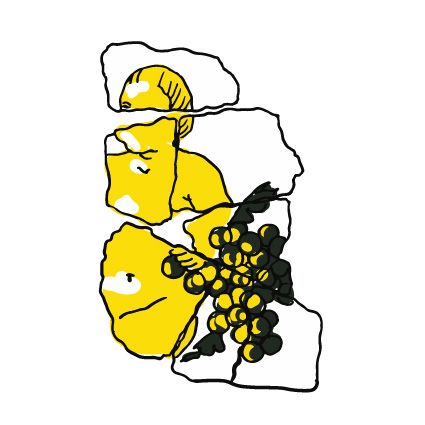
A falfestészet a római kor évszázadai alatt széles körben elterjedt művészeti ág volt, a középületekben és magánépületekben egyaránt alkalmazták. A tehetős polgárok gazdagon díszített, impozáns lakóházai mellett a szerényebb városi épületek, vidéki villák helyiségeiben is megtalálhatók voltak a festményekkel díszített falak birodalomszerte. A képek témája rendkívül változatos volt: az egyszerűbb, szinte jelzésszerű geometrikus mintázattól a nagyvonalú, részletgazdag jelenetekig. A mesterek dolgozhattak mintakönyvekből, vagy a megrendelő igénye szerint egyedi munkát is csináltak.
1904-ben elindult a feltáró munka a balácai villagazdaságban, és ennek során egy pusztulási rétegben a legkorábbi, 1. század végi lakóépületet díszítő falfestményrészletek kerültek elő.
A feltehetőleg egykori lakomaterem feketére festett falain növényi ábrák között állatalakok – létező és kitalált – bukkannak fel. A központi részeket nagyobb formákkal töltötték ki. Ilyen a gyermek Bacchus alakja, aki mellé állandó ismertetőjelként egy szőlőfürtöt is megfestettek.
Csirke Orsolya
régész
Erre haladjon tovább:
A Széchenyi István melletti szobor egy veszprémi zseni alkotása.
Mural painting was a widespread artistic industry during the centuries of the Roman era, observable in public buildings and personal residences alike. From the affluent citizens' richly decorated, imposing homes, through the more modest houses of the cities, to the rooms of rural villa estates, walls adorned with paintings are a common occurrence across the whole Roman empire. The subjects of these murals were extremely diverse: from the fundamental, symbolic geometric patterns, to the elaborate and highly detailed scenes.The masters either worked from pattern books or created unique works based on the requirements of their commissioners.
An excavation began in 1904 at the villa estate in Baláca. During the excavation procedures, from the destruction layer, a mural detail came to light which was decorating the wall of the earliest, 1st century residential building.
On the black walls of what was likely once a banquet hall, among the plant motifs, different animal depictions - both real and fictional - can be found. The central areas were filled with larger figures. Such is the portrayal of the young Bacchus, with the essential addition of a cluster of grapes, which is a characteristic of Bacchus depictions.
Orsolya Csirke
archeologist
Proceed to this:
The statue next to István Széchenyi is the work of a genius from Veszprém.